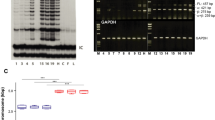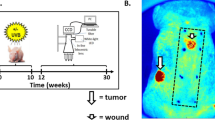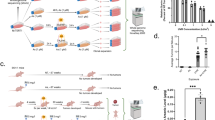Abstract
UV-radiation is a major risk factor for non-melanoma skin cancer causing specific mutations in the p53 tumor suppressor gene and other genetic aberrations. We here propose that elevated temperature, as found in sunburn areas, may contribute to skin carcinogenesis as well. Continuous exposure of immortal human HaCaT skin keratinocytes (possessing UV-type p53 mutations) to 40°C reproducibly resulted in tumorigenic conversion and tumorigenicity was stably maintained after recultivation of the tumors. Growth at 40°C was correlated with the appearance of PARP, an enzyme activated by DNA strand breaks and the level corresponded to that seen after 5 Gy γ-radiation. Concomitantly, comparative genomic hybridization (CGH) analyis demonstrated that chromosomal gains and losses were present in cells maintained at 40°C while largely absent at 37°C. Besides individual chromosomal aberrations, all tumor-derived cells showed gain of chromosomal material on 11q with the smallest common region being 11q13.2 to q14.1. Cyclin D1, a candidate gene of that region was overexpressed in all tumor-derived cells but cyclinD1/cdk4/cdk6 kinase activity was not increased. Thus, these data demonstrate that long-term thermal stress is a potential carcinogenic factor in this relevant skin cancer model, mediating its effect through induction of genetic instability which results in selection of tumorigenic cells characterized by gain of 11q.
This is a preview of subscription content, access via your institution
Access options
Subscribe to this journal
Receive 50 print issues and online access
$259.00 per year
only $5.18 per issue
Buy this article
- Purchase on Springer Link
- Instant access to full article PDF
Prices may be subject to local taxes which are calculated during checkout





Similar content being viewed by others
References
Alvarez-Gonzalez R and Althaus FR. . 1989 Mutat. Res. 218: 67–74.
Ananthaswamy HN and Pierceall WE. . 1992 Prog. Clin. Biol. Res. 376: 61–84.
Bleuel K, Popp S, Fusenig NE, Stanbridge EJ and Boukamp P. . 1999 Proc. Natl. Acad. Sci. USA 96: 2065–2070.
Brinkschmidt C, Christiansen H, Terpe HJ, Simon R, Boecker W, Lampert F and Stoerkel S. . 1997 J. Pathol. 181: 394–400.
Bockmuhl U, Schwendel A, Dietel M and Petersen I. . 1996 Cancer Res. 56: 5325–5329.
Boukamp P, Peter W, Pascheberg U, Altmeier S, Fasching C, Stanbridge EJ and Fusenig NE. . 1995 Oncogene 11: 961–969.
Boukamp P, Petrussevska RT, Breitkreutz D, Hornung J, Markham A and Fusenig NE. . 1988 J. Cell Biol. 106: 761–771.
Boukamp P, Popp S, Altmeyer S, Hulsen A, Fasching C, Cremer T and Fusenig NE. . 1997 Genes Chromosomes Cancer 19: 201–214.
Boukamp P, Stanbridge EJ, Foo DY, Cerutti PA and Fusenig NE. . 1990 Cancer Res. 50: 2840–2847.
Brash DE. . 1997 Trends Genet. 13: 410–414.
Brash DE, Rudolph JA, Simon JA, Lin A, McKenna GJ, Baden HP, Halperin AJ and Ponten J. . 1991 Proc. Natl. Acad. Sci. USA 88: 10124–10128.
Bürkle A, Chen G, Kuepper J-H, Grube K and Zeller WJ. . 1993 Carcinogenesis 14: 559–561.
Cerutti P, Amstad P, Larsson R, Shah G and Krupitza G. . 1990 Prog. Clin. Biol. Res. 347: 183–186.
Corominas M, Kamino H, Leon J and Pellicer A. . 1989 Proc. Natl. Acad. Sci. USA 86: 6372–6376.
de Gruijl FR. . 1996 Photochem. Photobiol. 63: 372–375.
de Laat JM and de Gruijl FR. . 1996 Cancer Surv. 26: 173–191.
de Laat A, van der Leun JC and de Gruijl FR. . 1996 Carcinogenesis 18: 1013–1020.
du Manoir S, Kallioniemi OP, Lichter P, Piper J, Benedetti PA, Carothers AD, Fantes JA, Garcia-Sagredo JM, Gerdes T, Giollant M, et al. 1995 Cytometry 19: 4–9.
Hill M, Hillova J and Mariage-Samson R. . 1991 In Vitro Cell Dev. Biol. 27A: 270–272.
Inohara S, Kitagawa K and Kitano Y. . 1996 Int. J. Dermatol. 35: 609–613.
Jonsson GG, Jacobson EL and Jacobson MK. . 1988a Cancer Res. 48: 4233–4239.
Jonsson GG, Menard L, Jacobson EL, Poirier GG and Jacobson MK. . 1988b Cancer Res. 48: 4240–4243.
Kallioniemi A, Kallioniemi OP, Sudar D, Rutovitz D, Gray JW, Waldman F and Pinkel D. . 1992 Science 258: 818–821.
Kawamitsu H, Hoshino H, Okada H, Miwa M, Momoi H and Sugimura T. . 1984 Biochemistry 23: 3771–3777.
Lehman TA, Modali R, Boukamp P, Stanek J, Bennett WP, Welsh JA, Metcalf RA, Stampfer MR, Fusenig NE, Rogan EM and Harris CC. . 1993 Carcinogenesis 14: 833–839.
Mahlamaki EH, Hoglund M, Gorunova L, Karhu R, Dawiskiba S, Andren-Sandberg A, Kallioniemi OP and Johansson B. . 1997 Genes Chromosomes Cancer 20: 383–391.
Marczynska B, McPheron L, Wilbanks GD, Tsurumoto DM and Deinhardt F. . 1980 Exp. Cell Biol. 48: 114–125.
Matsushime H, Quelle DE, Shurtleff SA, Shibuya M, Sherr CJ and Kato JY. . 1994 Mol. Cell Biol. 14: 2066–2076.
Mendonca MS, Boukamp P, Stanbridge EJ and Redpath JL. . 1991 Int. J. Radiat. Biol. 59: 1195–1206.
Nakagawa H, Zukerberg L, Togawa K, Meltzer SJ, Nishihara T and Rustgi AK. . 1995 Cancer 76: 541–549.
Naitoh H, Shibata J, Kawaguchi A, Kodama M and Hattori T. . 1995 Am. J. Pathol. 146: 1161–1169.
Peak MJ and Peak JG. . 1982 Photochem. Photobiol. 35: 675–680.
Peak MJ, Peak JG and Carnes BA. . 1987 Photochem. Photobiol. 45: 381–387.
Sherr CJ. . 1996 Science 274: 1672–1677.
Sheyn I, Noffsinger AE, Heffelfinger S, Davis B, Miller MA and Fenoglio-Preiser CM. . 1997 Hum. Pathol. 28: 270–276.
Tirkkonen M, Tanner M, Karhun R, Kallioniemi A, Isola J and Kallioniemi OP. . 1998 Genes Chromosomes Cancer 21: 177–184.
Acknowledgements
We would like to thank H Steinbauer for excellent technical help in tumorigenicity studies, Dirk Breitkreutz for critical discussions, and Brigitte Plagens for stylistic improvements. We also wish to extend our thanks to Brigitte Engelhardt and coworkers for their excellent photo work. This work was in part supported by grants from EC (ENV4-CT96-01272 to P Boukamp) (Bio4 CT 96o464 to NE Fusenig), Sander Stiftung Nr. 98.013.1 (to P Boukamp), and the DFG (Bo 1246 3-1 to P Boukamp).
Author information
Authors and Affiliations
Rights and permissions
About this article
Cite this article
Boukamp, P., Popp, S., Bleuel, K. et al. Tumorigenic conversion of immortal human skin keratinocytes (HaCaT) by elevated temperature. Oncogene 18, 5638–5645 (1999). https://doi.org/10.1038/sj.onc.1202934
Received:
Revised:
Accepted:
Published:
Issue Date:
DOI: https://doi.org/10.1038/sj.onc.1202934



